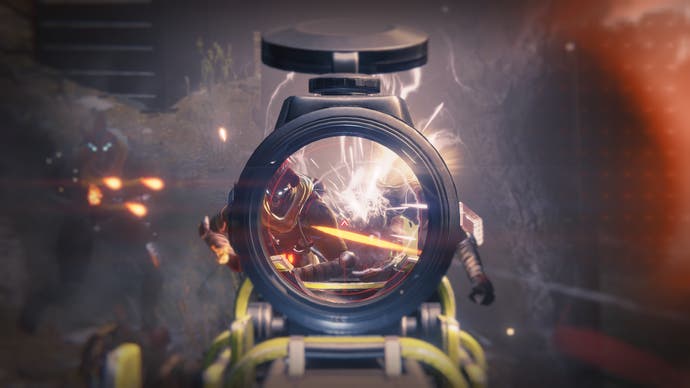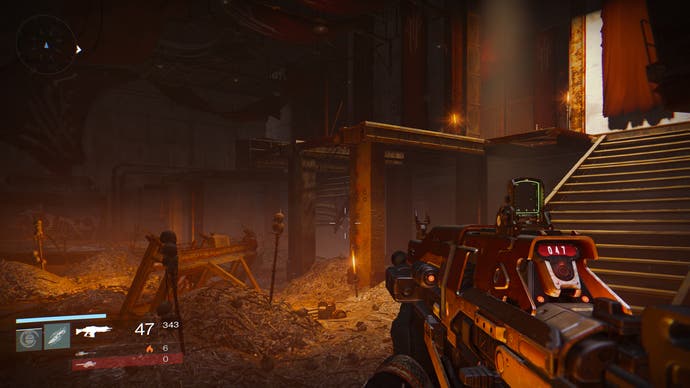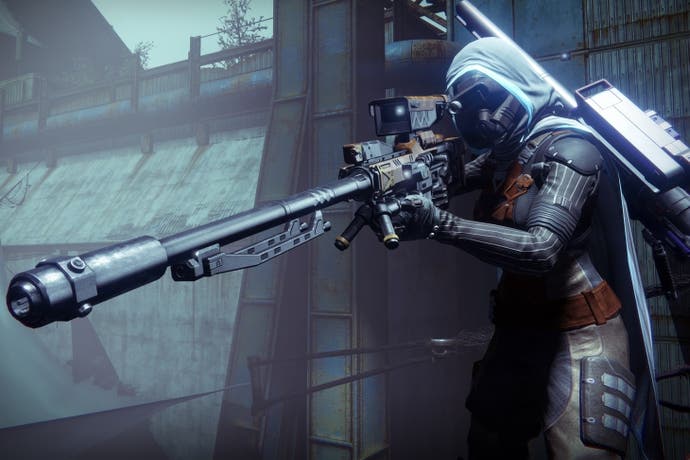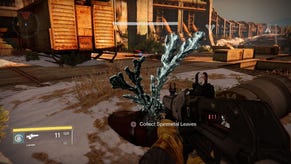Getting to play Destiny: better than Halo?
The time for talk is over.
A shooter is only as good as its sniper rifle. In Halo, the UNSC Sniper Rifle System 99 thunders with each pull of the trigger, as if Zeus himself has hurled a bolt of lightning down from the heavens and into the skull of your enemy. Zoom. Thundercrack. Headshot. Reload.
In Destiny, the sniper rifle - whatever its level, whatever its rarity, whatever its name - also thunders. Zoom. Thundercrack. Headshot. Reload. Except in Destiny, you see the word "Critical" pop up when you score that headshot. And you see a life bar evaporate. And you earn experience points. And maybe you see a message letting you know you've unlocked an upgrade for your sniper rifle, so you go into your character page, have a gander at the upgrade and buy it with the in-game currency, Glimmer.
But the feeling is the same. The common sense that governs Destiny's sniper rifle is the same that stood the SRS99 in such good stead for so long. It is the sense that the bullet really does travel across the map, hitting where and when it's supposed to, the sound of live fire echoing around a chasm, a virtual thud with real world impact. It's a familiar, reassuring feeling, and it's quintessentially Bungie.
Quintessentially Bungie: that's Destiny right there.
I shouldn't be surprised, really, to discover that Destiny plays like Halo. It is another sci-fi first-person shooter from the team that defined the genre on console, after all. You still have a reticule at the centre of the screen. You still have that console auto-aim that snaps towards the head of the enemy as you zoom in. You still have a red health bar and a shield that recharges, and so when the going gets tough it's still a good idea to find a rock somewhere, or a crate, or something - anything - solid, to hide behind for a few seconds. You still have a radar, with enemies displayed as red blobs and friendlies displayed as blue blobs. You still have space grenades that shriek for a second before exploding. You still have a melee attack. You still have massive levels and you still have vehicles. You still have a floaty jump (the Hunter class even has a double jump). And, crucially, you still have that 30 seconds of fun. Yes, I shouldn't be surprised to discover that Destiny looks and plays like Halo. And yet I am relieved.
I am relieved because I was worried, which is partly my fault and partly Bungie's, I think. 14 months ago I travelled to the Bellevue-based studio so excited to see it finally unveil its new game and left disappointed that it hadn't really unveiled anything. There's been a lot of talk since. I've heard Activision Publishing boss Eric Hirshberg preach the way of the "shared world shooter". I've heard whispers of progression, murmurings about always-online, seamless co-operative play, magic matchmaking and the promise of competitive multiplayer and a single-player campaign up there with the best Halo had to offer.
But the mystery was in how this would all tie together. The excitement was in wondering how Destiny would keep you coming back for more even after scores of hours of play, in a way that other shooters before now haven't. Bungie has for a year been vague in explaining all of this, which I interpreted as evasiveness, and as a problem. It turns out this was just Bungie being Bungie, those cryptic cads. Amid the concern I took my eye off the ball. I forgot to wonder about the core: how does Destiny play? It turns out, Destiny plays like Halo. And that's wicked.
"Amid the concern I took my eye off the ball. I forgot to wonder about the core: how does Destiny play? It turns out, Destiny plays like Halo. And that's wicked."

The Director, a kind of 2D galaxy map, is where Destiny's many modes are selected, and where my hour-and-a half of hands-on time with the PlayStation 4 version begins. We're skipping the Tower, then, which is unfortunate, because I quite like the sound of Destiny's social hub area. This is where players meet and greet, show off new gear, buy and sell, repair, fuss over character builds and tweak loadouts. Most importantly, however, the Tower is where groups are formed. It's where players gather before venturing out into the world Bungie has spent the last four years building.
For our hands-on this has all been organised in advance, like a well-oiled school trip. Instead of starting from scratch, I'm given a level eight Hunter. I could have picked a Titan, or a Warlock, but my soft spot for sniper rifles meant the Hunter, which can double jump up to crafty vantage points, was the obvious choice. I'm already in a three person fireteam, ready to take off in my spaceship, the solar system my oyster.
Destiny has a mode for every mood, Bungie hopes, but in this pre-alpha build options are limited. The finished game will include many, based on your progression through the game. Select Skirmish for competitive multiplayer, Campaign for the story, Patrol for an undirected experience - perfect for exploration, the discovery of easter eggs and public events - and a Raid for that hardcore co-op challenge. In the final game they will all link, but for today, we're all going on a Strike.
A Strike is designed to offer a fireteam around 30 minutes of arcade-style shooter action, with one or two mini-bosses to contend with before a tougher boss fight at the finish. Ours is set in Russia - or at least in what was Russia before a four-armed spider pirate alien race called The Fallen arrived and made themselves comfortable. We're travelling to the ruins of the Cosmodrome, a post-apocalyptic cacophony of twisted metal, burnt out cars, gutted installations and colony ships that, an age ago, failed to launch. The land is a miasma of snow, barbecue dirt and rust. The sun is high in the sky, casting real-time shadows onto the stillness. Later, when my fireteam come back to this place for another run, it is night. For my two fellow Guardians and I, Old Russia is where humanity's fightback begins and our search for epic loot starts.
After a short loading screen, complete with mission briefing voice over (kill The Fallen boss, essentially), we're on the ground. The first thing that strikes me as someone familiar with Halo is how easily Destiny's controls snap into place. I'm holding a DualShock 4 controller in my hands, but muscle memory forged through hundreds of hours of play on an Xbox controller means there's no need for adjustment. And as we explore the scarred remains of the Cosmodrome and engage small groups of The Fallen for the first time, tried and trusted techniques kick in: lob a grenade to take down shields, zoom in, fire, melee (or, for my Hunter, throw a knife) when necessary, empty clip, swap weapon, retreat, recharge shield, go again.
And if I'm playing Destiny like I would play Halo, the AI that governs The Fallen defends using textbook Covenant methods. There are Fallen grunts - easy pickings for headshots - and stronger Fallen, such as Captains, who use shields. The Captains seem more likely to do that Saturday night sidestep evasive manoeuvre Covenant Elites used to do all the time, but they buckle under the pressure of my trigger finger all the same.
We're still free roaming at this stage, Destiny's equivalent of a band jammin'. The Strike hasn't been triggered, so the serious work is yet to begin. If we were playing the game as it will be played in September, it's at this stage we'd likely bump into other players. A more powerful Fallen enemy appears - a kind of mid-level boss character with loads of life, and his name is displayed in a special yellow font. Attack it and you trigger a public event that charges you with killing it before the timer runs out. Others might spot you struggling and help out. Or not. This is the essence of Destiny's "shared-world shooter" philosophy. People are playing with and without you all of the time.
Kill The Fallen public event enemy - or not - and your Ghost, a kind of 343 Guilty Spark floating companion voiced by Peter Dinklage, aka Game of Thrones' Tyrion Lannister, casts judgement. Having Dinklage's dulcet tones accompany your adventure is as cool as it gets - and useful. Remember: Lannisters always pay their debts.
Before entering the installation we can explore, and we do, heading in the opposite direction to our Strike objective (on PS4 you can press the DualShock 4's touchpad to summon your Ghost and in doing so send out a pulse that adds a marker to help direct you). Inside an installation we stumble upon a pack of level 20 Fallen. Shooting them makes little impression, so we bail. But not before scouting for loot chests - cheeky sprints into places you have no business being in can sometimes pay dividends. Sometimes.

Back on track, we move past the objective marker and trigger the Strike. At this point, Destiny creates our own version of the environment - an instanced version - just for our fireteam. From here on in this is our Strike. We cannot be griefed by other players. No-one can steal our loot; indeed Destiny operates individual loot streams, like Diablo 3 does, so only you can see and pick up your spoils of war.
Inside the installation I stop to admire water falling from a leaking pipe, graffiti, and a skeleton sat almost nonchalantly on a bench - signs that long ago this place was home to human beings. No longer. While Destiny perhaps fails to match the graphical fidelity of the likes of Killzone: Shadow Fall, it's packed with lovely little details, glorious skyboxes and an art style to die for. Bungie isn't going for photo-realism here, it's going for personality, and it charms my socks off.
Combat inside is a tight affair. As a Hunter I spend much of my time hanging back, sniping, occasionally switching to my pulse rifle for mid-range bullet sprays. Every now and then I trigger my super power, the Golden Gun, which is the main event of the Hunter's Gunslinger codex (one path along the Hunter's tech tree). The Golden Gun gives me a couple of one-hit-kill shots, and is best used when you need something dead. Now. Then, after a few minutes, the on-screen message "super ready" appears, which makes me smile. Yes, my super is now ready, having recharged, but I also feel super ready for action! Bungie tells me there's still much user interface work to be done, but I hope they keep this in the game.
We turn a corner and creep up on the Fallen fighting the Hive, another of Destiny's alien races. The Hive, which I call 'well dressed Flood', have wizard units: powerful floating enemies who do what looks like electrical damage from within a protective bubble, Magneto style. Eventually we make our way towards a closed door leading out of a large room with a number of cover spots, some crates and a raft of exits. Tyrion - sorry! - Ghost, says it's a pretty tough to open lock, and needs some time. Oh, and Fallen are heading our way in waves.
So, it's time for our fireteam to prepare itself: I double jump onto a crate and prime my sniper rifle. My fellow players man the area below, ready to deal close and mid-range damage. They come, and we fire, popping headshots. Critical hits! Ghost says he will work faster as the second waves descends upon us. This time we're up against small flying machines that remind me of the Sentinels from Halo. Eventually, cloaked enemies with what look like laser blades enter the room and head straight for us. Oh, and a wizard appears, floating in mid-air. It's pretty chaotic, and the music, seemingly well aware of the danger we're in, ramps up in classic heroic Halo fashion. I run out of sniper rifle ammo, so in desperation switch to my heavy weapon, spraying the room with bullet hell. Then, to take down the wizard, the Golden Gun. The enemies are dead, and Ghost opens the door. It's time to loot.

The encounter reminds me of playing Halo co-op, waiting for 343 Guilty Spark to open some door as the Flood descend upon the Master Chief. The difference, it seems, is that Ghost isn't an insane, murderous robot eye. Ghost seems quite down to earth, really. I don't get the impression he wants try to obliterate all sentient life in the galaxy, anyway.
In a blink of an eye we're outside of the installation and in a large open area. In the distance is the Devil Walker tank first revealed as a public quest mini-boss at E3 last year. Here, in our Strike, it's a mini-boss just for us, and a tough one at that. It's protected by Fallen troops and more of those flying robots. I jump onto the roof of a crate to snipe from a distance, dodging fire from the tank's main cannon as my fellow Guardians go to work closer to the enemy. It takes some time for us to whittle down Devil Walker's health bar, and every now and then one of us dies, but there's plenty of time before a respawn, so reviving teammates is part of the natural order of combat. We get there: the tank explodes, we mop up the stragglers, then run over the shiny items on the floor: ammo, Glimmer and other materials for use back at the Tower appear in our inventory.
We're back inside the installation again. Moving from one type of area to another within a single level was Halo's trademark, and it looks like Destiny will follow suit. Even after all these years it remains an impressive technique: one minute you're lobbing grenades into a goldfish bowl packed with enemies, the next you're in a creepy corridor shooter. Lights under stairs project alien shadows. One room, dimly lit, is packed with bones and odd markings on the walls. It is called the Den of Devils. Upstairs a giant, floating robot sphere is sucking the life force out of worshipping (helpless?) Fallen, a sacrifice to its mysterious, nefarious intentions. I shoot first, and the life force stream stops. It appears we have the sphere's attention. It is a giant eye, we discover, the Strike end boss, Sepiks Ten. It's tough, but I reckon we can take it down, Unfortunately we're not allowed to. Bungie is saving this final encounter for E3 - no doubt on-stage during Sony's press conference.
Our Strike was a self-contained affair, crafted to make a point: that Destiny really is a shooter in which you can have a blast shooting aliens with your friends, that the 30 seconds of fun gameplay loop that served Halo so well for so long is alive and kicking, and that in Destiny you can throw a grenade into a pack of enemies and watch bodies burn. Point proved. Destiny is a hell of a lot of fun.
But as the bullets are flying it's easy to forget Destiny is a "shared-world shooter". We'll be reminded of this later, perhaps while we're on a Patrol, collecting docking caps for some quest we just picked up from a beacon, darting around a huge map on our Sparrow one second, the next dismounting in the blink of an eye, shooting Fallen, opening a loot chest, summoning our Sparrow and mounting it in the same slick move, then speeding off into the distance.

The hunt for better and better loot will keep me going for months, but Destiny's emergent massively multiplayer gameplay is what will keep me playing for years. Take on a random public quest, for example, and perhaps you quickly realise you're in over your head. Then, over the hill comes another Guardian, a white knight to save you from certain death. You're saved. You wave. You group up, summon your Sparrow then speed off towards some loot-packed adventure over the next hill, the sun setting on the ruins of the Cosmodrome. Or the Moon. Or Venus. Or maybe Mars. Destiny's greatness will lie in how well it sows the best of World of Warcraft and the best of Halo into a seamless virtual fabric. I'm still waiting to find out if Bungie has successfully threaded the best of Blizzard's MMO, but I'm certain it's successfully threaded the best of Halo.
Destiny is Halo evolved, and it's a natural evolution, given the way gaming has gone in the 13 years since the release of the first game in the series. Playing Destiny now, the underrated Halo 3: ODST all of a sudden makes much more sense. I see Destiny as lots of New Mombasas, each fleshed out and given their own identity, that combine to form a mythic science fiction world in which all roads lead back to The Tower.
This article was based on a press trip to Bungie's offices in Bellevue, Washington. Activision paid for travel and accommodation.










